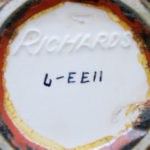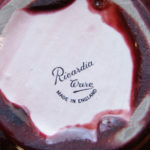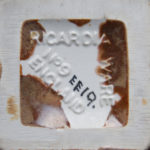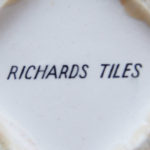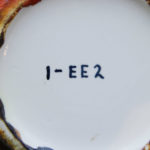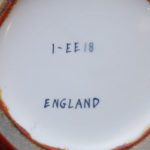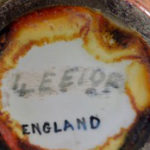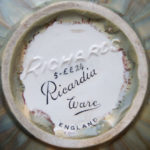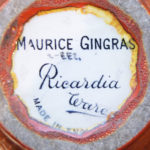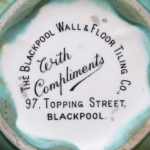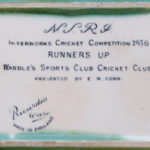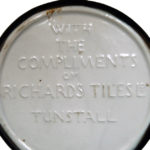Ricardia Art Pottery Pages: Ricardia Introduction Ricardia Glazes Ricardia Shapes
Nearly all Ricardia is marked on the base with printed, moulded or painted marks, or a combination some or all of them. While printed or moulded marks appear on nearly all pieces, many do not have painted marks. Painted marks give the shape number and glaze code. The one or two digits before the hyphen indicate the shape, and the digits after the EE indicate the glaze. For more information on shapes and glazes click the links above this text.
It is interesting that Ricardia marked its ceramics so carefully and often in such detail considering they were seemingly not produced for sale or marketed. If they were indeed only produced as promotional items, it seems pointless to devise and mark them with a new brand, and particularly to paint on shape and glaze numbers. Perhaps this latter part was due to the decorators, who were used to painting pattern numbers on to the bases of ceramics as part of their job. Pieces were presumably only marked with their country of origin so that they could be sent abroad to foreign distributors, agents and retailers and comply with the McKinley Tariff Acts.
The Marks
The most common mark seen is Mark 1 below, which is printed in black and lightly impressed into the body. The second most common mark is Mark 2, where the company name RICHARDS in italicised capitals is moulded in relief into the base. Other, less commonly found marks include:
Mark 3, a smaller sized and perhaps later version of Mark 1. This may even be postwar, judging by the glossy, simpler dripped and mottled glazes on pieces it is found on, and the general style of the mark.
Mark 4 where the words RICARDIA WARE ENGLAND and the shape number are moulded in relief into the base.
Mark 5, which has RICHARDS TILES printed in black and lightly impressed into the body.
Mark 6 which has the handpainted shape and glaze code. Sometimes ENGLAND may be included due to the McKinley Tariff Acts which required goods produced for export to be marked with their country of origin in English.
Mark 7 shows a complete set of marks.
The remaining marks include marks for specific retailers, agents or distributors of Richards’ tiles, and commemorative marks. The final commemorative mark is interesting. E.R. Corn is Edmund Reginald Geoffrey Corn, a descendent of Edward Corn who, in 1837, founded the business that would become Richards Tiles. Known as ‘Mr Geoff’ around the factories and company, employees remembered his fondness for cricket as much as his kindness and charitable works. It is also dated, putting a single ‘post in the ground’ for the time period Ricardia was produced in. Today, it’s amusing to think that a prize or award given to a sporting club would be a cigarette box, and a capacious one at that!
This is a work in progress. If you have any more information about Ricardia, please contact me by clicking here.
Photographs by and copyright Mark Hill Publishing Ltd.



